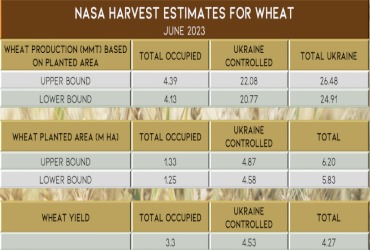As Ukraine remains one of the world’s top 10 agricultural producers and exporters, continuous monitoring of food production in the region has always been critical in a food security and market stability context. This is especially true in light of the ongoing war-driven disruptions to farm management and agricultural supply chain logistics, the effects of which are felt not only locally but globally. As conflict in Europe’s breadbasket rages on, NASA Harvest continues to evaluate agricultural production using Earth observation information throughout both Ukrainian-controlled and Russian-occupied regions of Ukraine.
Wheat is typically planted throughout Ukraine between August and September each year, with harvest taking place between July and August of the following year. NASA Harvest, based on satellite analysis, estimates total wheat production for Ukraine to be between 25 and 26.5 Million tons, with between 21 and 22 Million tons coming from the Ukrainian controlled territories and between 4.1 and 4.4 Million tons coming from Russian occupied territories.
Yield is estimated to be higher than last season, at 4.27 T/Ha for all of Ukraine (4.53 T/Ha within Ukraine held and 3.3 T/Ha in Russian held territories). On the other hand, planted area is decreased relative to last year, with between 5.8 and 6.2 Million hectares planted across Ukraine (between 4.6 and 4.9 MHa in Ukrainian controlled areas, and between 1.2 and 1.3 MHa planted in Russian held territories).
Overall, this year’s wheat production estimate is close to last year’s estimate – driven by lower planted area and higher yields relative to last year – but is slightly below the 5 year average (prior to the war) of 27.9 Million Tons. It is important to note that this is assuming that all planted wheat will be harvested, and that satellites cannot provide information on who harvested the wheat and whether Ukraine will see the economic benefits of its fertile farmlands.

Remotely-sensed Earth observation data enables NASA Harvest scientists to observe where and how much wheat has been planted, to monitor crop health as the wheat grows, and ultimately to estimate the amount of expected wheat yield prior to the end of the season.
Click here to see more...